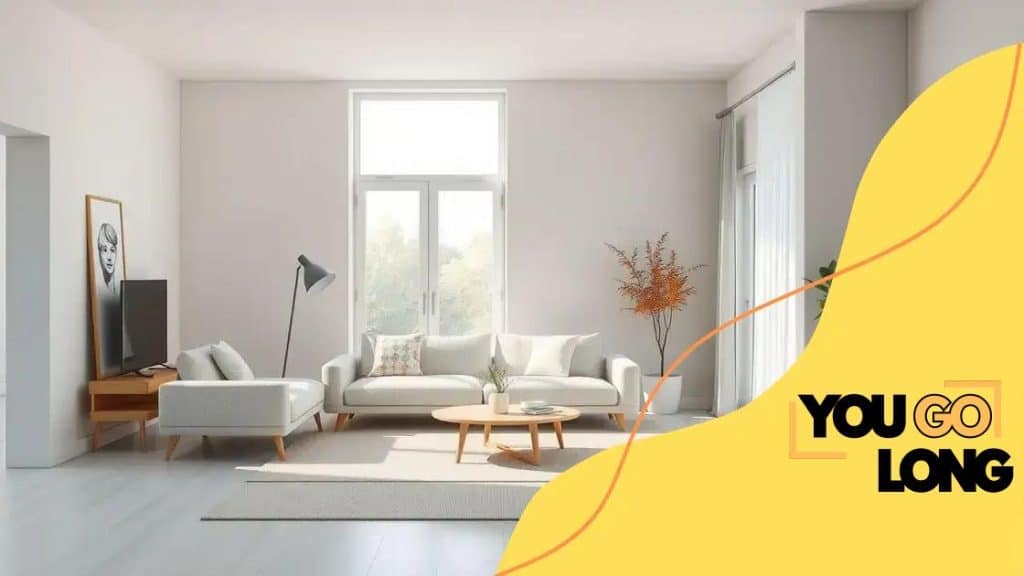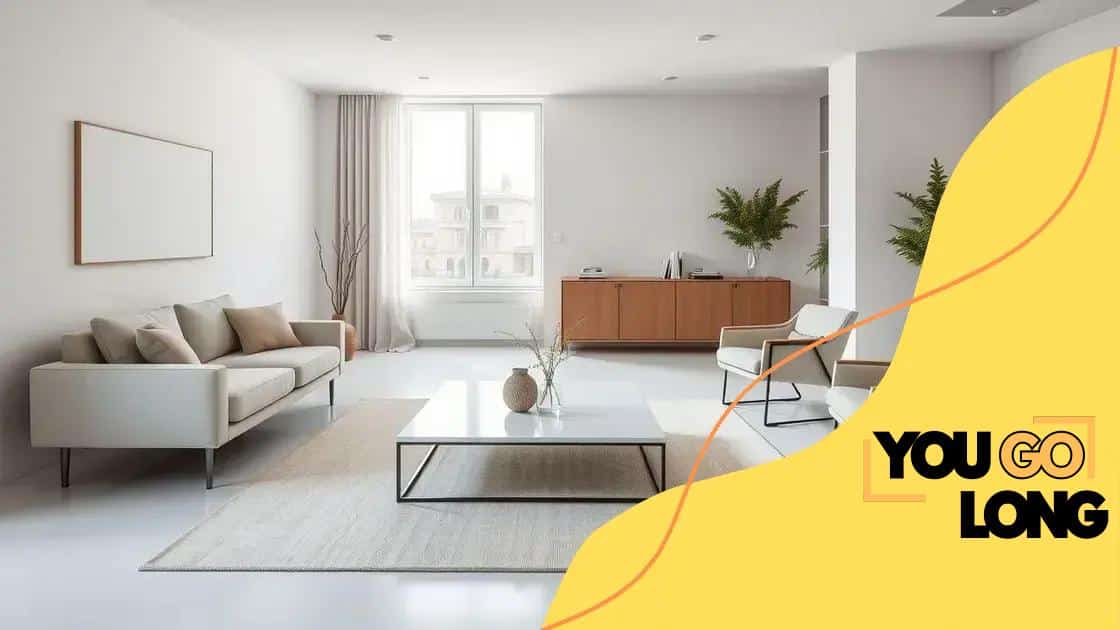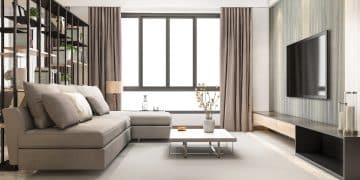How to create a minimalist home design in 2025

Advertisement
To create a minimalist home design in 2025, focus on essential furniture with clean lines, a neutral color palette, and natural elements that enhance space and promote simplicity.
Have you ever thought about how how to create a minimalist home design in 2025 could transform your daily life? Minimalism is about more than just aesthetics; it’s about creating a peaceful environment that reflects your values. Let’s dive into practical steps to achieve this serene space.
Understanding minimalist design principles
Understanding minimalist design principles is essential for creating a serene space in your home. This style emphasizes simplicity and functionality.
Core Principles of Minimalism
The foundation of minimalist design relies on a few core principles. It’s not just about removing clutter; it’s about carefully choosing each element to enhance the overall aesthetic. By focusing on essential items, your space can evoke calmness.
Advertisement
- Functionality: Each piece of furniture should serve a purpose.
- Simplicity: Choose designs that are clean and straightforward.
- Neutral Colors: Use a muted palette to create a soothing atmosphere.
- Natural Light: Allow as much natural light as possible to highlight spaces.
Implementing these principles, your home design can enhance your lifestyle. The fewer items you have, the easier it is to maintain a relaxing environment. This approach fosters peace and clarity, contributing to a more mindful existence.
Choosing the Right Elements
To emphasize the minimalist aesthetic, select furnishings that both look good and are practical. Think about combining natural materials with a functional design. For instance, wooden tables can add warmth, while sleek, glass lamps can keep your space feeling open.
Incorporating greenery can also enhance the environment. Plants not only purify the air but also add a touch of vibrancy to your decor. Choose a few plants that complement your design without overwhelming the space.
Advertisement
Choosing the right color palette for minimalism
Choosing the right color palette for minimalism is crucial in creating a tranquil and spacious environment in your home. Colors can significantly influence the mood and perception of space.
Key Color Principles
In minimalist design, it is essential to select a palette that enhances simplicity. A limited color range creates harmony and draws attention to the beauty of minimalism. Soft neutrals like whites, grays, and beiges often work well, as they provide a serene foundation.
- Neutral Shades: These colors create a calm atmosphere that reflects light and space.
- Accent Colors: A few careful selections can add character without overwhelming.
- Monochromatic Schemes: Using different shades of the same color can maintain unity.
- Natural Tones: Earthy colors can bring warmth and connection to nature.
Using a cohesive color scheme allows you to emphasize the furniture and decor, making each piece stand out. For instance, if you choose a light background, add a few dark or vibrant accents to provide contrast. This approach keeps the overall aesthetic inviting while remaining streamlined.
Implementing Your Palette
When applying your selected color palette, consider the flow of each room. A consistent use of colors across various spaces can unify your home. It’s also important to account for natural light, as it can change how colors appear throughout the day.
You might want to test paint samples in different areas. Observe how they look at different times to ensure they work harmoniously with the light. Ultimately, the goal is to create an atmosphere that embodies minimalism while remaining functional and inviting.
Essential furniture pieces for a minimalist home

Essential furniture pieces for a minimalist home play a key role in achieving a functional and aesthetically pleasing environment. Choosing the right pieces helps maintain the clean lines and open space that minimalism is known for.
Key Furniture Items
When furnishing a minimalist space, it’s important to focus on items that are both practical and visually appealing. Aim for a few standout pieces rather than cluttering the space with many different items. Here are some essentials that can elevate your minimalist design:
- Neutral Sofas: A simple, low-profile sofa in a neutral color creates a calming focal point.
- Streamlined Coffee Tables: Look for tables made from natural materials like wood or glass to keep the flow light.
- Multi-functional Furniture: Items like storage ottomans can serve several purposes while saving space.
- Minimalist Chairs: Choose sleek chairs that complement your sofa, prioritizing comfort without excess.
Incorporating furniture with clean lines and a limited number of colors ensures that your space feels cohesive. Each piece should reflect the overall design philosophy of less is more.
Experimenting with Layout
Once you have your essential pieces, experiment with their arrangement to optimize space. Avoid pushing all the furniture against the walls; instead, create cozy groupings to promote conversation. This layout not only looks inviting but also maintains an open feel. Keep pathways clear, and use rugs to define areas within larger rooms.
Don’t forget the importance of negative space! Leaving areas free of furniture can make your home feel larger and more open. Minimalism isn’t just about the items you choose; it’s about how you choose to display them.
Incorporating natural elements in your design
Incorporating natural elements into your design can enhance the overall feel of a minimalist space. It brings warmth and life, making your home feel more inviting.
Key Natural Elements
By integrating organic shapes and materials, you can create a balance between simplicity and nature. Here are some elements to consider:
- Plants: Adding greenery not only purifies the air but also adds color and vibrancy to your rooms.
- Wood: Incorporating wooden furniture or accents can create a warm, earthy feel in your space.
- Stone: Natural stone surfaces, like granite or marble, can add a sophisticated touch to countertops and decor.
- Textiles: Use natural fibers like cotton or wool for cushions, rugs, and throws to add texture while keeping the look clean.
Enhancing your home with these elements can help cultivate a sense of tranquility. For example, placing a few potted plants in your living area not only beautifies the space but also connects it to outdoor environments.
Creating Harmony with Nature
When you design with nature in mind, think about how each element interacts with others in your home. Ensure that the natural features complement your color palette and furniture choices. A cohesive look will make each piece feel more intentional.
Additionally, consider how light interacts with natural elements. Large windows can draw in sunlight, highlighting plants and natural materials. This not only brightens the space but also enhances the feeling of openness.
Maximizing space in small areas
Maximizing space in small areas is essential for creating a functional and appealing minimalist home design. When dealing with limited square footage, every inch counts, and careful planning can make a big difference.
Smart Furniture Choices
Opt for multi-functional furniture that can adapt to your needs. For instance, a sofa bed can serve as both a stylish couch and a sleeping space for guests. Look for tables that can expand or contract based on your requirements. Another great option is storage ottomans, which can provide seating and extra storage.
- Wall-mounted shelves: These save floor space while displaying decor.
- Foldable desks: They can be tucked away when not in use.
- Stackable chairs: Ideal for accommodating guests without taking up too much room.
Using these types of furniture allows for versatility without compromising style.
Creative Layout Solutions
Consider the layout of your small space carefully. Open floor plans can create the illusion of more space. Try to keep furniture arrangements minimal and avoid blocking pathways. Use area rugs to define zones in a single room, which can help create distinct areas for different purposes.
Mirrors are another excellent tool for making spaces feel larger. Placing a large mirror across from a window can reflect light and create a sense of depth. Additionally, choose light colors for walls and furniture. Bright colors can make a room feel open and airy, enhancing the overall environment.
In summary, creating a minimalist home involves thoughtful choices in design and furniture. By focusing on essential pieces, using light colors, and incorporating natural elements, you can turn your home into a stylish sanctuary. Maximizing small spaces is all about smart furniture and arrangement. Embrace simplicity to create a calming environment where you can unwind and feel at peace.
FAQ – Frequently Asked Questions About Minimalist Home Design
What are the key principles of minimalist design?
The key principles include simplicity, functionality, and a focus on essential elements while eliminating clutter.
How can I maximize space in a small area?
Use multi-functional furniture, create an open layout, and choose light colors to make the area feel larger and more inviting.
What natural elements should I include in my design?
Incorporate plants, wooden furniture, and textiles made from natural fibers to create warmth and connect with nature.
Why is a light color palette important in minimalist design?
A light color palette enhances space perception, makes the area feel brighter, and promotes a calming atmosphere.





